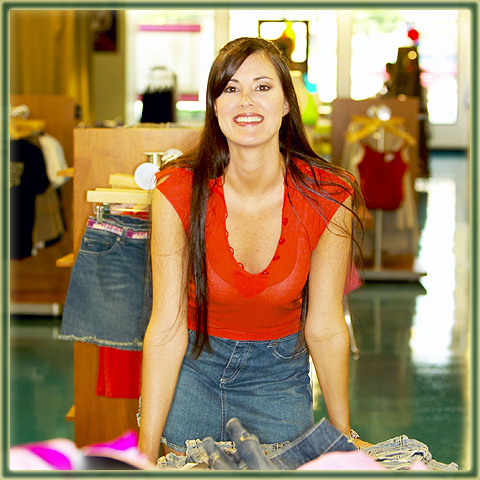World of Boutiques

Following on from my ’New Industrial Revolution’ article, which talks about everyone being able to design and manufacture their own industrial goods; i.e. the democratization of Manufacture; I now turn my focus to retail, where everyone can set up their own Boutique online.
Before I get into the definition of a Boutique, I would just like to reflect on a number of emerging trends, particularly in the area of fashion retail. In real-world shopping malls, some of you may have come across ’Pop-up Shops’; small, temporary boutiques which appear and then disapper within a matter of weeks. If you’ve been to Iceland recently, you cannot fail to have noticed the rapid growth and appearance of designer collectives and their retail outlets - whether these be in side streets, or residential basements and garages, or the unused area at the back of a large warehouse facility. In the bricks-and-mortar world, prime retail real estate is expensive, and fashion sales can be very seasonal, as for many other businesses, which makes for extended periods of inactivity and leads to a struggle to pay the rent. Having several designers club together and temporarily lease retail spaces - whether town hall, or school for a weekend market, or some other low-cost and slightly off the beaten track destination, is the cleverest and most common-sense option available.
The one thing that all these designers need year-round, is an outlet for brand-building and promotion. They need to be able to resonate with their potential consumers, by developing an environment which fosters the right brand associations and idealogies, and backs them up with re-inforcing content, media and consumer events. The Internet is the perfect place to serve these small fashion brands - why? Let’s get back to the definition of ’Boutique’.
For most people a Boutique is just a small shop, often associated with expensive goods. For our purposes, the value of the goods is irrelevant, although the economics of volume / quantity vs price / quality can play some part. My definition of Boutiques is ’Small shops with Personality’, this is usually because Boutiques are run by enthusiasts, and in terms of Fashion Boutiques, often the designers themselves. But this is just one facet of ’Personality’, the other, equally important side is that of personal service.
Generally, you know that you will usually pay more for goods bought in a Boutique, vs buying something similar from a Department Store or Hightstreet Chain. Now I love Selfridges as much as the next person, and much like Harrods and Harvey Nicks, their big idea / concept is along the lines of Boutiques within Stores; a sort of shop-within-a-shop model. The point is though that you rarely get as good a service in these Department Stores, as you would if you visited the flagship stores for each of the brands featured. And even on a flagship level, service can often by variable, as well as invariably impersonal, although the big Bond Street brands make use of a number of great marketing techniques (chiefly around packaging concepts), that everyone can learn from - which we will see later. The point is that Boutiques are infinitely more personal and much better predisposed to give better services, although this alone won’t suffice.
Boutiques are all about personality as well as personal service, and the online manifestation of a Boutique has to be able to carry through this culture of personability and service. This is where a Social Commerce solution like Affino comes into play, as to be able to reproduce your Boutique experience online, you need to be able to infuse the retail environment with personality, and the best way to do this is via Community tools such as Blogs, Message Boards and Personal Profiles where customers can post their own pictures and comments - giving rise to proper Brand Advocacy.
There’s a very interesting TED Talk by Rory Sutherland, where he talks up the importance of ’Nice Touches’ - that is to say low-cost, small but memorable differentials in the product or service which leave a big impact on the customer. Lots of things which soon become ubiquitous through mass take-up started as nice individual touches - examples of this include the after dinner mint at restaurants, and specifically the use of fortune cookies at Chinese restaurants. Rory Suterland refers to the Cruet Set - Art Deco Stainless Steel Salt & Pepper shakers from Virgin Atlantic Upper Class, which feature the embossed legend ’Stolen from Virgin Atlantic Upper Class’ - for obvious reasons. Finally, I would like to mention my dad, who loves, nay needs to have a piece of chocolate or two to accompany his coffee - night and day. As a result, all the quality coffee houses and restaurants which value my dad’s custom, make sure that every coffee cup sent out to Jon Karlsson is accompanied by one or two pieces of chocolate. Any article you read about Net-a-Porter will mention how important the packaging is to its customers - it is a significant part of shaping the whole customer experience and reinforcing positive assocations and brand values.
Of course there are no quick tricks to coming up with a smart differential - this has to come from the Boutique owner based on their experience of their own customers, and what really matters to those customers. In all kinds of activities and interchanges, it is often quite small things which have a totally improportional significance - almost everything Apple does is reinforced by a philosophy of nice touches - the experience starts on the website, is continued through the store, the packaking and the unboxing - right up to and including when you first interface with your new Apple devices. So, packaging - both physical and intangible is critical to the customer experience, as a result, all Boutique Retailers should heed the power of intangibles, as well as the enormous signifcance of great packaging.
11 Key activities successful Boutiques need to embrace:
Incentivise your customers - Use a points rewards system, progressive discounts based on spend and frequency, access to pre-sales and special sales events, drive the association with VIP Status for regular customers
Clearly state and frame your business philosophy - Feature a clear and elegant description of how everything in your Boutique works - how you deal with product selection, orders and returns, and how you reward your customers with special due care and attention and loyalty bonuses
Univeral Contact Point - Give you customers a direct and easy channel of communication to make contact at any stage - particularly with regard to order assistance / issues
Delivery Details - Always include clear and accurate information on deliveries - e.g. time of delivery - estimated day, and whether AM or PM - based on delivery option selected. For me, this can be the area of the shopping experience that leads to the most anxiety - waiting for your package to drop! Any assistance in this area will enormously improve the customer experience
Relevant Packaging - Make your packaging is brand-relevant and memorable - It does not have to be costly, just harmonious to your retail brand image - to prompt brand re-call and stimulate repeat purchase. Many shopper retain original packaging for storage purposes; e.g. shoe boxes, so make your packaging work for you
Returns Handling - When mailing product, always include a pre-paid return postage label (if you’re extra clever, you will make your original packaging re-useable so that it can handle returns). For many online shoppers I know, the returns process is a key part in the try-after-you-buy nature of online retail
Use ’Mementos’ - Include a ’personal touch’ with every shipment - ideally some kind of collectible brand memento (what I like to call ’memorabilia’) - that resonates strongly with the target audience, this could be a pin badge, an inexpensive charm for a charm bracelet or similar - obviously dependent on value of order, but great for encouragement of repeat purchase
Use Product Alerts - Alow customers to sign up to Product Preferences - indicating Brands and Product Areas they are interested in, and getting regular email newsletter updates when new products are added to a range, or put on sale / special offer
Use Customer Notifications - The very best online Boutiques keep their customers notified every step of the way - you get a notification when you order, when your order has been packed / assembled, and despatched - followed by a request for feedback a week or so after delivery
Reference complementary brand markers - Use your site blog to showcase absolutely relevant complementary brands, media and imagery. This is something that To-orist does quite well
Make Recommendations - The end game of personal service is that you know your customers better, and are able to recommend suitable complementary products to match their tastes
Generally you need to remember that the Amazons of the world are always going to be able to sell products cheaper than you and in a broader range, and will be able to invest vast sums in clever site functionality, promotions and marketing activities. Boutiques counter this with personality and personal touches, including service of course. Anyone can set up a business online, but only relatively few will go the distance and prosper ...

Did you find this content useful?
Thank you for your input
Thank you for your feedback
Upcoming and Former Events
Affino Innovation Briefing 2024
Webinar - Introduction to Affino's Expert AI Solutions - Session #2
Webinar - Introduction to Affino's Expert AI Solutions - Session #1
PPA Independent Publisher Conference and Awards 2023
Meetings:
Google Meet and Zoom
Venue:
Soho House, Soho Works +
Registered Office:
55 Bathurst Mews
London, UK
W2 2SB
© Affino 2024


















